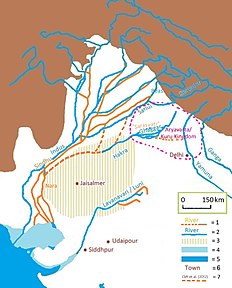Luni River
| Luni River Sagarmati | |
|---|---|
 Course of River Luni or Lavanaravi river, south of the estimated route of the ancient Sarasvati river | |
| Native name | (language?) |
| Location | |
| Country | India |
| State | Rajasthan |
| Physical characteristics | |
| Source | |
| • location | Pushkar Valley near Ajmer |
| • elevation | 550 m (1,800 ft) |
| Mouth | |
• location | Gujarat |
• coordinates | 24°39′N 71°11′E / 24.650°N 71.183°ECoordinates: 24°39′N 71°11′E / 24.650°N 71.183°E |
| Length | 495 km (308 mi) |
| Basin size | 37,363 km2 (14,426 sq mi) |
| Basin features | |
| Tributaries | |
| • left | Jawai River, Sukri River, Guhiya River, Bandi River |
| • right | Jojari River |
The Luni is the largest river in the Thar Desert of northwest India.[1] It originates in the Pushkar valley of the Aravalli Range, near Ajmer, passes through the southeastern portion of the Thar Desert, and ends in the marshy lands of Rann of Kutch in Gujarat, after travelling a distance of 495 kilometres (308 mi). It is first known as Sagarmati, then after passing Govindgarh, it meets its tributary Saraswati, which originates from Pushkar Lake, and from then on it is called Luni.[2]
In 1892, Maharaja Jaswant Singh of Jodhpur constructed Jaswant Sagar in Pichiyak village between Bilara and Bhavi of Jodhpur district. It is one of the largest artificial lakes in India, and irrigates more than 12,000 acres (49 km2).[2]
Etymology[edit]
The Luni is also known as the Lavanavari or Lavanavati, which means "salt river" in Sanskrit, due high salinity of its water.[2]
Overview[edit]
The Luni River basin is 37,363 km², which includes all or part of the Ajmer, Barmer, Jalore, Jodhpur, Nagaur, Pali, and Sirohi districts of Rajasthan and the Banaskantha and Patan districts of northern Gujarat. Its major tributaries are the Sukri, Mithri River, Bandi, Khari, Jawai, Guhiya and Sagi from the left, and the Jojari from the right.[1]
The Luni River begins near Ajmer in the Pushkar valley of the western Aravalli Range at an elevation of about 550m. At this point, the river is also known as the Sagarmati. The river then flows in the southwest direction through the hills and plains of the Marwar region in Rajasthan. The river flows south-west and enters the Thar Desert before dissipating into the Rann of Kutch, traversing a total of 495 km. In spite of the high salinity, it is a major river in the region and serves as a primary source of irrigation. The Luni is not saline until it reaches Balotra, where high salt content in the soil impacts the river.[1]
The Luni may have been the southern portion of the historic Ghaggar-Hakra river channel.[1]
Tributaries[edit]
The Jawai, Sukri, Guhiya, Bandi and Jojari rivers are the main tributaries of Luni river. The Jojari is the only tributary that merges to the right-bank of the river while other 10 tributaries reach its left bank. All the tributaries except Jojari originates from the Aravalli hill.[3][4][5]
Dams and irrigation[edit]
The dams in Luni river are:[3]
- Dantiwada dam
- Sipu dam
- Jaswant Sagar Dam - built in 1892 by Maharaja Jaswant Singh.It is one of the largest artificial lakes in India.
The two major irrigation projects on Luni river are Sardar Samand and Jawai dam.[3]
Flash Floods[edit]
Flash floods have occurred in the Luni river as the river flows on a shallow bed and the riverbank soil is easily flattened by the rain water.[3]
The worst flood was happened in 2006, when the desert region received heavy rain. The water levels rose to 15–25 feet submerging the surrounding region. The 2006 flash floods in caused water levels to rise to as high as 15–25 feet submerging many parts along the river in the Barmer district. A large number of people and animals died in the flood.[3]
In 2010, another flood occurred but there were less casualties.[3]
References[edit]
- ↑ 1.0 1.1 1.2 1.3 Carling, Paul A.; Leclair, Suzanne F. (16 July 2018). "Alluvial stratification styles in a large, flash-flood influenced dryland river: The Luni River, Thar Desert, north-west India". Sedimentology. 66 (1): 102–128. doi:10.1111/sed.12487. ISSN 0037-0746.
- ↑ 2.0 2.1 2.2 Luni River, The Imperial Gazetteer of India. Vol. 16. 1909. pp. 211–212., see also The Imperial Gazetteer of India
- ↑ 3.0 3.1 3.2 3.3 3.4 3.5 "Luni, the Indian river with saline water that doesn't drain into any sea or ocean: Facts you need to know". India Today. Retrieved 7 March 2020.
- ↑ Luni Basin (Department of Irrigation, Government of Rajasthan)
- ↑ Luni tributaries (Department of Irrigation, Government of Rajasthan)
